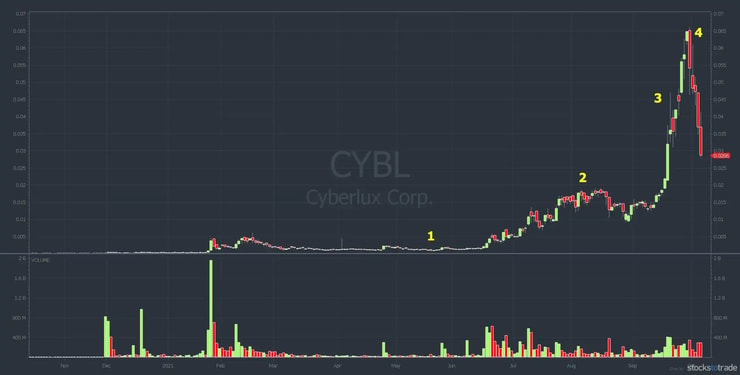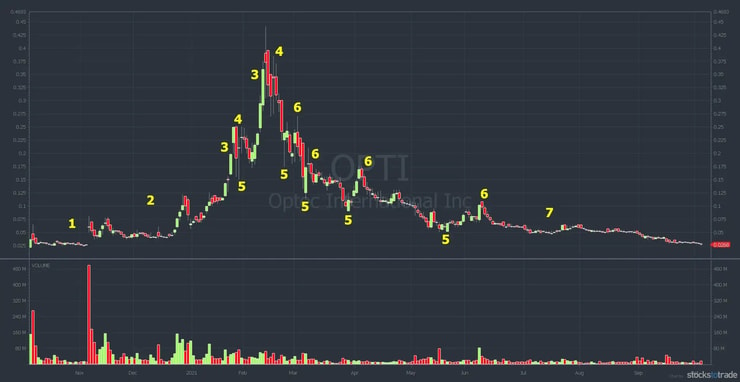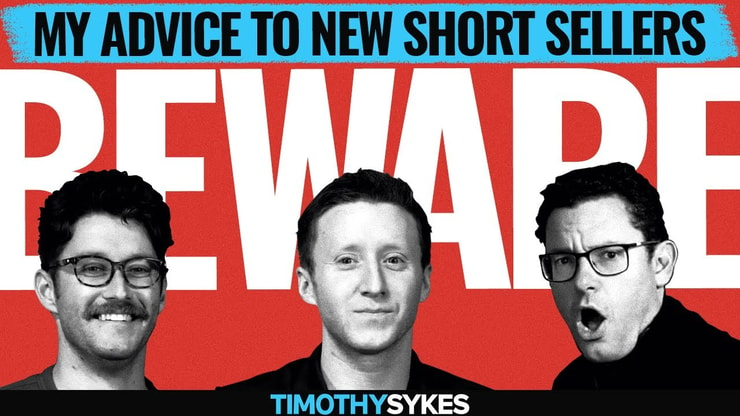You can learn how to short a stock on Questrade in 5 minutes…
But if you want to learn how to short sell without blowing up your account in the process, take your time learning this risky strategy!
EXPERIENCE pays, newbies blow up, it's always the same & yet they don't realize it until it's too late, nor do those who follow the newbies into risky/half-assed strategies by only thinking about the potential upside not the downside risks they take far too often #knowledgeiskey
— Timothy Sykes (@timothysykes) April 26, 2020
I used to short a lot. That’s how I made my first million…
I don’t do it much anymore. It isn’t because the penny stocks I like to trade have gotten any less junky…
It’s because the market has gotten a bit wiser. And the shorts without a plan are the easiest targets out there.
Read on to see how you can avoid the risks and get the rewards out of shorting on Questrade!
Table of Contents
What Does Shorting a Stock Mean?

Shorting a stock is the counterpart to buying a stock. In shorting, you sell the stock before you buy it, with the goal of buying it after it has lost value.
Simple enough, right? Not quite.
Shorting a stock is one of the riskiest strategies in trading.
When you buy a stock, or go long, you can only lose the money you put in.
But when you short a stock, you can lose your whole account. I know I sound like your dad right now, but take a look at this chart…
This short squeeze on $HKD is SO awesome snd I hope you're all watching to see why I don't short anymore, several big short sellers are rumored to be trapped (not that they'll admit it on Twitter) as this strategy is RISKY AF. Retweet this if you understand how risky shorting is! pic.twitter.com/v7t2KxU3Pc
— Timothy Sykes (@timothysykes) July 29, 2022
What’s crazy is that this isn’t as high as AMTD Digital Inc. (NYSE: HKD) got. It cruised into the $2,500 range before crashing.
And it blew up a lot of accounts in the process.
Can You Short Stocks On Questrade?
Yes, you can short stocks on Questrade — as long as you’re a Canadian trader. The SEC doesn’t want U.S. traders getting too clever with their tax returns.
If you’re looking for a truly international broker, I have some suggestions for you later on.
Questrade isn’t the first broker I’d recommend when it comes to shorting…
That honor goes to TradeZero. I think TradeZero is THE BEST broker for shorting hard-to-borrow stocks.
That’s what the penny stocks I trade are usually considered.
Sign up to TradeZero here and I’ll give you a free gift!
Why Would You Short A Stock?
Take a look at my 7-step pennystocking framework:
Remember this chart well, its the basis for my 7-step framework, @30DayBoot & @completepenny & you must study not to fall prey to greed/ignorance or you'll get wrecked like 90% of traders. It's VITAL to sell into excessive strength/hype, do not just hold & hope like most newbies pic.twitter.com/QsAGHsI6lp
— Timothy Sykes (@timothysykes) February 28, 2021
Most of the penny stocks I trade follow a similar pattern. They run on speculation, then crash when the promoters take their gains and leave the newbies holding the bag.
If you’re only trading them on the way up, you’re missing out on half of the moves!
How to Short a Stock: 5 Steps
Whether or not shorting is part of your strategy, you should still know how to do it. Here are the 5 steps…
Step 1: Set Up Your Margin Account
Set up a brokerage account if you don’t already have one. You can enable margin at that time, or set it up later.
If you want to use margin leverage in a trade, you’ll need $2,000 in your account.
Step 2: Build Your Trading Plan
This is important! Never trade without a plan.
A trading plan will make you think twice about random trading. It will also make you think about your goals, and acceptable losses if your trade goes against you.
A powerful charting platform like StocksToTrade will help you build your watchlists, identify entries and exits, and track breaking news. StocksToTrade is my absolute favorite trading platform. It was built by and for traders (I even had a hand in its design), so it’s got everything you’ll need to spot short selling opportunities.
Give StocksToTrade a try for 14 days — only $7!
Step 3: Open a Short Position
Go to the Trade screen, and switch the Order Type to Short Sell.
Step 4: Take Small Gains — And Cut Losses Quickly!
This is the part a lot of short sellers leave out…
And it’s the most important part.
Go for singles, and cut losses quickly.
You won’t win all of your trades. How you lose matters.
Your job as a trader is to profit from volatility, do NOT fall in love with any trade or asset as a trade is not profitable until you lock in your profits & getting emotional can muddy the waters. Similarly, it's difficult to cut losses fast if you become too emotionally involved
— Timothy Sykes (@timothysykes) December 7, 2021
Step 5: Cover the Position
To exit your short position, you need to buy back the stock — that’s called covering.
Short Selling Strategies

Short selling is the key to many effective strategies. Just because I hardly do it doesn’t mean it’s a stay-away.
I still teach these strategies in my Trading Challenge. Some of my most outstanding former students have gone on to make these strategies central to their trading success.
Take my former student Tim Grittani. He’s made $13.5 million, mostly through short selling.
Don’t get me wrong, short selling isn’t your ticket to the millionaires’ club. Concentrating on your education is the only way I’ve seen it done.
Strategy 1: Tim Grittani’s Overextended Gap Down
This is one of Grittani’s go-to strategies. He teaches it in his excellent DVD, “Trading Tickers.” He has a whole chapter dedicated to this strategy.
Here’s the rundown:
- The stock is up a lot, and looks overextended
- It’s had several consecutive green days without going red
- Once things turn red, there’s a major momentum shift that really brings out the sellers
Why I Like It
This strategy just makes sense. Think about it:
-
The overnight longs are screwed. If they bought the stock right before it went red, they’ll have lost money
- Smart traders who’ve been in the stock a while will take profits
- There’s room for the stock to come down
There’s another big reason to like this strategy — Grittani tracked it and found that it was one of his most profitable strategies. That’s good enough for me!
Strategy 2: The Cliff Dive
Go back to the 7-step framework diagram…

Step #4 is the ‘cliff dive.’ That first step is a doozy.
Why I Like It
Sometimes the cliff dive comes in the form of the overextended gap down. But this isn’t just technical weakness at play here…
It’s the repeated pattern that penny stocks follow.
Cyberlux Corp. (OTCPK: CYBL) is a crap company. The only reason it spiked was because it was promoted. This is how shady penny stock companies pump their stock value. The stock doesn’t stay up for long.
Time it right, and you could have a big win on your hands.
Strategy 3: The Long Kiss Goodnight
This is Step #7 of my framework, the fate that awaits all crappy penny stocks…
Like a bouncy ball, most promoted stocks will have progressively smaller bounces off of their big spike. There are several profit opportunities on the way.
Why I Like It
After the cliff dive, things settle down. This means less potential profit — and less potential risk.
Pros and Cons of Questrade Short Selling

Like everything in trading, you have to weigh short selling’s pros against its cons. Here’s what I like and don’t like.
Advantages of Short Selling
There’s one big reason that I like short selling…
It’s half of trading.
If you only go long you can only trade bullish moves. When you add shorting to your arsenal, you can trade the entire chart.
Disadvantages of Short Selling
I’ll cover the specifics in the next section.
For now, I’ll just leave this here:
Costs and Risks of Short Selling Stocks on the Questrade Platform
To become a self-sufficient trader, you need to account for every cost and risk. Short selling has more than its share.
Unlimited Losses
Like I said before, there’s no cap on your potential losses from short selling — except for the money in your margin account. When your losses exceed your leverage, your broker will do a margin call, asking you to deposit more cash or transfer securities into your account.
These losses sometimes happen because of…
Short Squeezes
A short squeeze happens when the price shoots up, and shorts rush to cover… sending the price further up.
The snowballing price action just convinces more longs to get in on the move, sending more shorts running for the exits.
LOL $SIVBQ right back up, I really feel for the shorts but remember they like pain so they're happy in a sick way
— Timothy Sykes (@timothysykes) March 29, 2023
Don’t say I didn’t warn you.
Less Potential Gain
The flip side of unlimited losses is limited potential gains. Your profits are constrained by how far a stock’s price can drop.
Other Costs
Shorting has significant costs, which can make a big difference to a trade’s profitability.
First is the borrow fee, which you owe for borrowing the stock. This cost can get quite high on hard-to-borrow stocks.
Next comes the margin rate. This is the interest you owe on the money you borrow for your trade.
The Market’s Long-Term Upward Bias
The S&P 500 has gained more than 50% in the past three years. Just because spikes are usually short-lived doesn’t mean a stock will return to its pre-spike level.
Is Short Selling Evil?

I call short selling the dark side of trading… but that doesn’t make it evil.
There are unethical traders on both sides of trades. Some try to inflate a stock’s price so they can profit. Some want to deflate a stock’s price so they can profit.
Questrade Alternatives
Choosing a broker isn’t a lifelong commitment. In fact, I think it’s better to try out several so you can find out what fits you best…
If you want to check out short selling on other brokers, I have articles on Wealthsimple Trade (another Canadian broker), Interactive Brokers, and Schwab here.
Key Takeaways
Shorting a stock on Questrade isn’t complicated…
It’s all the strategy surrounding short selling that’s the hard part!
Here’s the good news: trading isn’t rocket science. Lots of people spend more time learning skills that have fewer real-world prospects.
Newbies get themselves into trouble short selling because they don’t understand the risks. They haven’t spent time working on their strategy.
They’re playing the odds, and the odds aren’t good. A 2019 study called “Day Trading for a Living?” looked at the success rates of Brazilian traders over a 2-year window, and found that 97% of traders with more than 300 days actively trading lost money. Only 1.1% earned more than the Brazilian minimum wage ($16 USD per day).
We don’t have exact figures on the profitability of U.S. traders, but it’s probably similar. I hear from traders every day who’ve made account-ending mistakes.
That’s part of the reason why I offer my Trading Challenge. I can’t make you into a profitable trader, but I can tell you how my 31 millionaire students have done it. To a person, they’ve put a ton of hours in, and didn’t rush things. Eventually, their hard work paid off.
If you think you have what it takes, apply to the Challenge here. We don’t take everyone. But if you think you can work harder than 99% of the rest of the market — we want you.
What do you think about short selling? Let me know in the comments!






Leave a reply